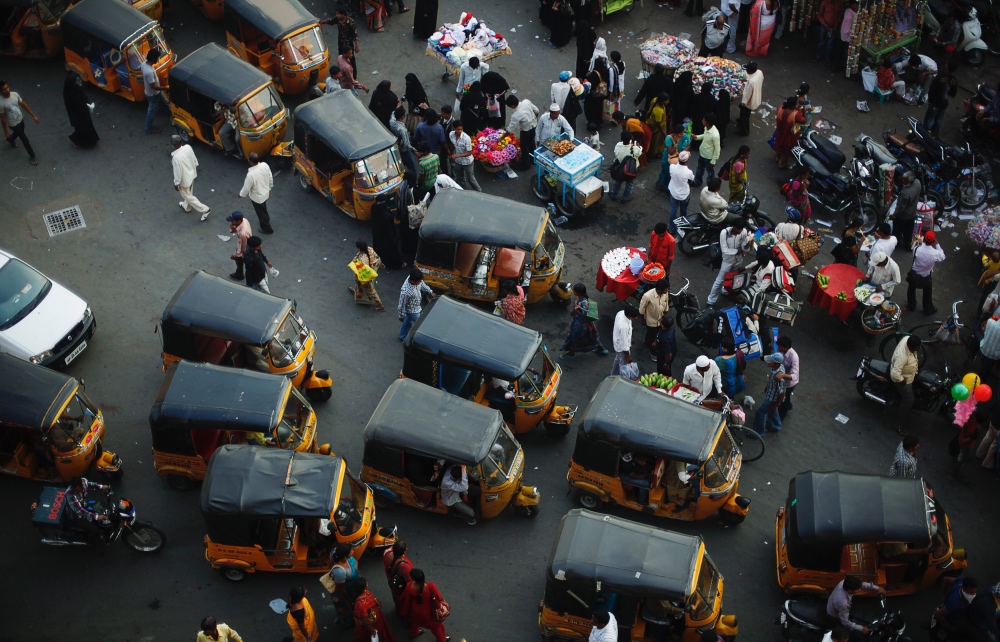Mumbai, India
Thomson Reuters Foundation
A proposal by the southern Indian state of Andhra Pradesh to have three capitals rather than one could be a model for more equal development and help release pressure from the country’s overcrowded cities, say planning experts.
Last month, the government of Andhra Pradesh passed the Decentralisation and Equal Development of All Regions Bill to pave the way for three cities to be the executive, judicial and legislative centres, rather than build a new capital city.

Auto rickshaws sit in a traffic jam in the old city in central Hyderabad in the southern state of Andhra Pradesh, on 6th March, 2012. PICTURE: Reuters/Vivek Prakash
Having three capitals is an anomaly in India, where state capitals have long been centres of power, drawing the bulk of investment and infrastructure building, and becoming magnets for thousands of migrants from the villages every day seeking jobs.
But with increasingly crowded cities and lopsided economic growth in many states, decentralisation is desperately needed, said Bhanu Joshi, a former member of a committee that studied the feasibility of the multi-capital plan.
“Indian states focus on putting all their capital into just one big city instead of giving a boost to decentralised development, where more cities are adequately empowered and sustained to allow for balanced development,” he said.
“Andhra Pradesh is endowed with different types of natural resources – a policy of balanced regional development is the only way forward,” Joshi, a political scientist, told the Thomson Reuters Foundation.
Andhra Pradesh was split in two in 2014 after a decades-long movement for a separate state, with Telangana hived off the north-western part in June 2014.
Andhra Pradesh’s capital, Hyderabad, became the capital of Telangana, but will also remain capital of Andhra Pradesh for a period of up to 10 years so the state can establish its own capital.
Andhra Pradesh’s former chief minister N Chandrababu Naidu, who is credited with transforming Hyderabad into a thriving technology hub, decided to build a new capital, Amaravati, touted as a “smart city” with environment-friendly features.
But the plan was beset by protests of farmers unwilling to give up land, and warnings of the ecological impact and potential for flooding from building close to the river.
A new government led by Chief Minister YS Jagan Mohan Reddy, who took office last May, commissioned studies into the feasibility of a multi-capital plan, then scrapped the Amaravati project based on their recommendations.
Amaravati – where some administrative buildings have been built – is to be the state’s legislative capital, with the coastal city of Visakhapatnam becoming the executive capital and Kurnool the judicial capital, Reddy said.
“We do not want to develop one area utilising all our available financial resources while other areas suffer due to lack of funds,” he told reporters.
Crowded capitals
Several countries, from Brazil to Myanmar, have tried to decongest their crowded capitals by moving or building new ones, but with mixed success.
Bolivia, Chile, Malaysia and the Netherlands are among countries with two capitals each, while South Africa – cited by Reddy as a model – has long had three capitals.
In India, some states had summer and winter capitals during the British colonial era.
A few states, in recent decades, have invested in developing smaller cities as manufacturing, academic or tourism hubs to create jobs and address sharp regional imbalances.
India has five megacities with populations of more than 10 million each, and is forecast to have two more by 2030, according to the United Nations.
Each of these cities – including Mumbai, Delhi and Kolkata – suffers from lack of adequate public transport and affordable housing, along with increasing congestion and pollution.
While big cities create wealth and generate employment, they also drive climate change impacts, and worsen inequality and exclusion, said the UN
But simply declaring a city a capital will not guarantee decentralisation or more equal development, said Srinivas Chokkakula, a fellow at the Centre for Policy Research, a thinktank in New Delhi.
“The idea of decentralised growth needs to be institutionalised and there need to be deliberate efforts to ensure investments,” he said.
Authorities will face infrastructure challenges and environmental risks including climate change in each of the three cities, and will need to build efficient linkages between them, he said.
“Calling a city a capital may bring some attention and some investments, but the challenge will be sustaining it for a more balanced, equitable growth and development,” he said.
Protests
The state is setting up regional economic development boards that will ensure the benefits of economic growth are accessible to everyone, authorities have said.
But farmers in more than two dozen villages who pooled at least 13,355 hectares of land for the new capital in Amaravati have protested for weeks against the decision to abandon the project, which authorities had said would be a financial boon for landowners.
A wider public consultation process would have helped make the decision more acceptable, said EAS Sarma, a land rights activist and former bureaucrat who had filed a petition against the Amaravati project.
What’s now required is proper planning, or moving the heads of departments and the secretariat to Visakhapatnam will “impose a severe stress on the resources of the city” including water, housing and land, he said.
“It will only create new problems for the residents.”





